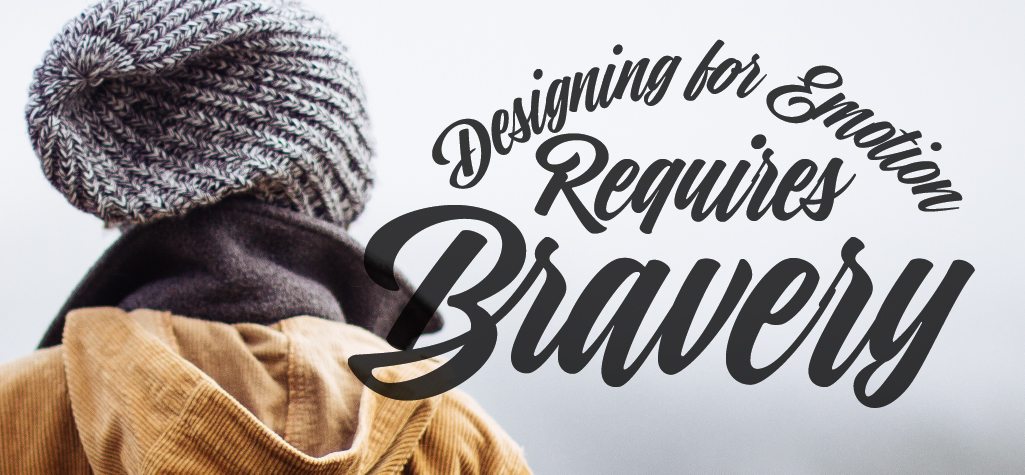Emotional connections are two-way streets. Evoking real and meaningful emotion from our customers requires that we, as designers, bring real and meaningful emotion to the table too.
I work for Intuit, where we’re making emotional connections with our customers a top priority. In an earlier article, I talked about the need to establish a deeper emotional connection to create Magical and Meaningful experiences. Understanding what delight feels like and the supporting principles to design for delight is a big step forward, but it’s not enough. Getting Magic and Meaning from our hearts into our customers’ hands means changing the way we work, the way we share ideas, and the way we define success. That type of change requires bravery.
Three Acts of Bravery to Increase Emotion for Customers
1. Protect the soul of your design
Good design makes us feel. We know good design when we see it and we’ve all seen great design concept get whittled down and diluted through multiple review cycles and the development process. Maintaining the essence of what makes a concept great is hard work, whether in a company the size of Intuit—with 8,000 employees around the world—or a small company with only a few employees. It requires dogged persistence and dedication to the design. It’s tiring and you have to put yourself on the line. You have to work to make believers out of your stakeholders and development partners so they can feel what you want the customer to feel.
Protecting the soul of the design means designing not just for customers, but also for your internal audience. Designing for the way they experience your design concept makes it that much easier for you to get that concept into your customer’s hands. For us, this has meant a serious commitment to prototyping. A prototype conveys a complete experience and can evoke the emotions and reactions of the complete experience.
A prototype speaks for itself and doesn’t break down into component parts—it can be experienced as a whole. By contrast, mock-ups in PowerPoint, communicate elements of experience on distinct pages. It’s much easier for reviewers to carve up an experience that’s given to them in pieces. It’s also easier for reviewers to apply preconceived notions of the experience to a mock-up since it relies on the communication skills of the designer rather than the design of the experience. This scenario can quickly lead to compromised designs and unnecessary reworking of concepts. The value of prototyping isn’t new, but prototyping takes time, and we’ve learned the extra time up-front saves significant time downstream. The prototypes let us share complete experiences with customers for feedback, generate excitement—and expectations—in leaders, and enable us to work out potential production issues for the development team. That makes the design concept hard to push back on, keeping its soul intact and expediting the process.
Prototyping isn’t the only way to be deliberate about designing experiences for internal audiences. Mike Kruzeniski is currently the Design Lead at Twitter, but when he was UX Creative Director for the Entertainment Experience Group at Microsoft, he spearheaded a prioritization system that united the design and development teams. A simple change to their internal prioritization system engaged their development partners in the design concepts in a more meaningful way and kept the soul of their designs alive. See his talk “Poetry & Polemics in Creating Experience” to see how replacing numbers (P0, P1, P2, P3) with words (soul, heart, body) brought emotion into the conversation and rooted both teams in what actually mattered to the customer.
2. Be bold and vulnerable
Emotion begets emotion. It’s contagious and grows organically, but it has to start somewhere. As designers, we’re the heart of customer empathy in our organizations and it’s our responsibility to keep the customer alive as a human being—not a segmentation. This means we have to be the ones who bring humanity to our work. It can be scary being human at work. It sounds funny, but it’s easier to hide behind a task or a discipline and let divided roles disperse accountability. You might be surprised, however, how much more efficient the work can be, how much better your products are, and how much more fun you have when you’re staying aware that before we are designers, developers, GMs, or CEOs—we’re all people first.
As designers, we’re the heart of customer empathy in our organizations
I’ve tried to model this behavior and it’s scary. Way scarier than I thought it would be. Every time I meet with a leader to share my work on emotion, I begin by giving them a gift. I’ll do some research on what they like and find something that builds a personal connection between us.
I got our CTO a book on the structure and ingenuity of racecars and talked about the British racing cars my dad collected. I signed one of our Chief Design Strategists up for a video app to document her sabbatical and talked about the ways I’d tried to capture memories from my travel experiences. I gave our founder a bottle of wine that we served at my wedding. Even when the gift missed the boat (I gave a vegan a cookbook on southern cooking and charcuterie!), it still generated warmth and a deeply sincere desire to build on the work I shared in the meeting. It seems obvious–who doesn’t like a gift?—but every single time, I’d tremble going in to the meeting. Why? Because it required getting past the intimidation created by titles and finding a way to connect with each leader as a person. It was unconventional and required opening up and sharing something personal about myself. There was the added risk of me assuming something personal about them with my gift selection.
It was terrifying but it worked every single time. It was actually a perfect analogy for connecting with our customers. If we don’t do our research well enough, we miss the connection. If our attempt isn’t authentic, the connection falls flat.
When I shared my emotion work at our internal design conference I wanted to recreate a similar connection with the audience. I wanted to go beyond an ice breaker, this wasn’t just about warming the crowd. I wanted to create a connection between each of them with each other, and with me. I had the people in the room take one another’s pulses and then revealed to them the importance of a heartbeat (also the code name for my emotion project) in my life.
3. See the product through the customer lens, not the other way around
People feel, products don’t. By definition focusing on emotion forces us to keep the customer perspective in mind and stops us from slipping into a product-centric view. But focusing solely on the emotions evoked by the product experience only helps us respond or react to what customers currently feel with regards to the product. This usually finds teams working to remove pain points.
That’s a good start, but to truly exceed expectations, we need to understand what customers are feeling in the moments that matter most to them, which are usually moments that occur outside of the product. This requires bravery because it’s not always popular to show your teammates or leaders that they’re overinflating the role of the product in the customer’s life. With our products like QuickBooks, TurboTax, and Mint, the goal is to have our customers spend less time using them so they have more time to spend on what matters most to them—their business and their life.
For that reason, we’ve had to redefine our view of end-to-end thinking. We’ve made a lot of progress in consistency of design and tone by mapping the complete end-to-end experiences of our products, but it’s still been the end-to-end product experience. While we’ve always done significant user research to understand our customers’ context and what they care about, it wasn’t always clear how to translate those insights into key moments of impact in our products.
We’ve recently started combining end-to-end mapping of those moments with a focus on customer context and emotion. Some of the moments are in the product, but many are not. Either way, our focus is on the decisions customers’ make in their life, not the actions they take in our products. This approach helps ensure that we’re prioritizing our efforts against the things that will most improve our customers’ lives, rather than the things we can most easily measure. This is helping us shift conversations from increasing subscription rates to increasing our customers’ ability to make good decisions.
Check out how Airbnb storyboarded their customer experiences and realized the vast majority of the moments that mattered to their customers happened offline. The process led them to make a significant, and worthwhile shift, into mobile as the way to balance the online/offline “dance.”
Bravery Is Hard, but the Pay off Is worth the Effort
If you’re wondering if it’s really worth it to be bold watch the “Kissing Strangers” video that went viral last year. I showed this on stage to our entire experience design community, including several executives. This video perfectly illustrates the emotional arc of practicing bravery: overwhelming fear, beautiful human connection, and ultimately the payoff of perseverance. It’s uncomfortable to watch in the beginning, but the moment of the kiss is a powerful reminder that humans are hard wired to connect with one another. At the end, it’s amazing to see the lightness that these people exhibit, as if they’ve known each other for years, and yet they’ve just met … and kissed.
So I challenge you to be bold, believe in what you do, fight to create a work environment with emotion and humanity, and, above all, create experiences that are truly worthy of your customers’ heartbeats.








